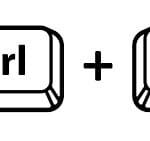Table of Contents
The command key, also known as the Apple key or open Apple key, is a modifier key present on Apple keyboards. It allows users to enter keyboard commands in applications and in the system. The command key is symbolized by the ⌘ symbol, which was chosen by Susan Kare and is encoded in Unicode as U+2318. The symbol originated from Nordic countries where it represents cultural locations and places of interest. Apple computers prior to 1980 did not have a command key, but it was introduced on the Apple III in 1980 and the Macintosh in 1984. Most Macintosh keyboards have two command keys, one on each side of the space bar.
In this article, we will explore the history, function, and equivalents of the command key on PC keyboards. Whether you are a Mac user or a PC user, understanding the command key and its functions can enhance your productivity and efficiency when using a computer.
History of the Command Key
The command key has a rich history that dates back to the early days of Apple computers. It was first introduced on the Apple III in 1980 and later became a standard feature on the Macintosh in 1984. However, even before its official debut, early Apple computers like the Apple II Plus and Apple IIe had command keys that were used in combination with other keys to perform specific functions.
One of the notable aspects of the command key is its iconic symbol, ⌘, which has become synonymous with Macintosh menus. The choice of this symbol was made to avoid overusing the Apple logo in the menu system. Designed by Susan Kare, the ⌘ symbol is encoded in Unicode as U+2318 and holds significance in Nordic countries, representing cultural locations and places of interest.
Over the years, the design of the command key has undergone changes. In 2007, the Apple logo was removed from the key and replaced with the word “command” on U.S. keyboards. This change aligned with Apple’s evolving design aesthetics and the need for clarity in keyboard markings.
https://www.youtube.com/watch?v=3QYKsf0qzKY
The Evolution of the Command Key
“The command key has evolved alongside Apple’s innovations, reflecting the company’s commitment to intuitive user interfaces and streamlined workflows. Its introduction on the Apple III and subsequent adoption on the Macintosh marked a significant step in the development of user-friendly computers.”
The command key’s evolution reflects Apple’s dedication to providing users with efficient and intuitive interactions with their computers. From its modest beginnings on early Apple computers to its iconic status as a symbol of Macintosh menus, the command key has become an integral part of the Apple user experience.
Function of the Command Key
The command key plays a crucial role in enhancing productivity and efficiency for users of Apple devices. Its primary function is to enable users to enter keyboard shortcuts in applications and within the system. Following the Macintosh Human Interface Guidelines, developers are recommended to utilize the command key for this purpose, allowing users to perform various actions with ease.
When it comes to keyboard shortcuts, the command key serves as the modifier key that, when pressed in combination with other keys, triggers specific functions. Here are some commonly used keyboard shortcuts facilitated by the command key:
- Cut: Command + X
- Copy: Command + C
- Paste: Command + V
- Select All: Command + A
- Bold: Command + B
- Italicize: Command + I
- Underline: Command + U
In addition to these common shortcuts, the command key is also used for a variety of other tasks. It enables users to open, close, and switch between applications smoothly. The command key allows users to create new files, find specific words or phrases within documents, and perform other essential actions, making it a versatile tool that streamlines various computer tasks.
By utilizing the command key and its associated shortcuts, users can significantly improve their workflow and efficiency.
It’s worth noting that these keyboard shortcuts may vary slightly depending on the specific application. However, the command key consistently plays a fundamental role in enabling these shortcuts across different Apple software applications.
Moreover, the command key provides an intuitive way to access various menu options within applications. When pressing the command key, application menus are temporarily displayed, indicating the available shortcuts associated with each menu option. This feature allows users to navigate through complex menus quickly and execute functions without the need to navigate through multiple layers of menus.
The image above visually represents the command key on an Apple keyboard, reminding users of its importance and functionality.
| Command Key Function | Keyboard Shortcut |
|---|---|
| Cut | Command + X |
| Copy | Command + C |
| Paste | Command + V |
| Select All | Command + A |
| Bold | Command + B |
| Italicize | Command + I |
| Underline | Command + U |
Command Key Equivalents on PC Keyboards
On PC keyboards, the command key is not present. However, there are equivalent keys on Windows keyboards that serve similar functions. The Windows key, marked with the Windows logo, is the closest equivalent to the command key. It acts as a modifier key and is used to open the Start menu or Start screen in Windows 8.
Another commonly used modifier key on Windows keyboards is the Alt key. Similar to the command key, it allows users to enter keyboard shortcuts in applications and the system. The Alt key is often used in combination with other keys to perform specific tasks or actions.
It’s worth noting that depending on the keyboard layout, the position of the Windows and Alt keys may be different compared to the position of the Command and Alt keys on an Apple keyboard. However, in macOS, users have the flexibility to configure the keyboard preferences so that the Windows key functions as the Command key and vice versa, providing a more familiar experience for those transitioning from a Mac to a PC.
FAQ
What is the function of the Command key on a PC keyboard?
The Command key, also known as the Apple key or open Apple key, is a modifier key present on Apple keyboards. It allows users to enter keyboard commands in applications and in the system.
When was the Command key first introduced?
The Command key was first introduced on the Apple III in 1980 and later on the Macintosh in 1984. Early Apple computers like the Apple II Plus and Apple IIe also had command keys.
What is the symbol for the Command key?
The symbol for the Command key is ⌘, which was chosen to avoid overusing the Apple logo in the menu system. It has since become the primary modifier key symbol in Macintosh menus.
What are some common keyboard shortcuts using the Command key?
Commonly used keyboard shortcuts include cut (Ctrl+X), copy (Ctrl+C), paste (Ctrl+V), select all (Ctrl+A), bold (Ctrl+B), italicize (Ctrl+I), and underline (Ctrl+U).
Are there equivalent keys to the Command key on PC keyboards?
On PC keyboards, the Command key is not present. However, there are equivalent keys that serve similar functions. The Windows key, marked with the Windows logo, is the closest equivalent to the Command key. The Alt key is also commonly used as a modifier key for keyboard shortcuts in Windows.
Can the position of the Windows and Alt keys be swapped in macOS?
Yes, in macOS, the position of the Windows and Alt keys can be configured in the keyboard preferences so that the Windows key becomes the Command key and vice versa.







